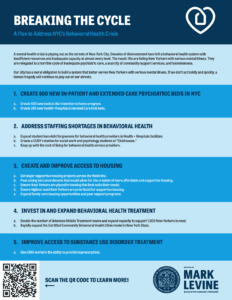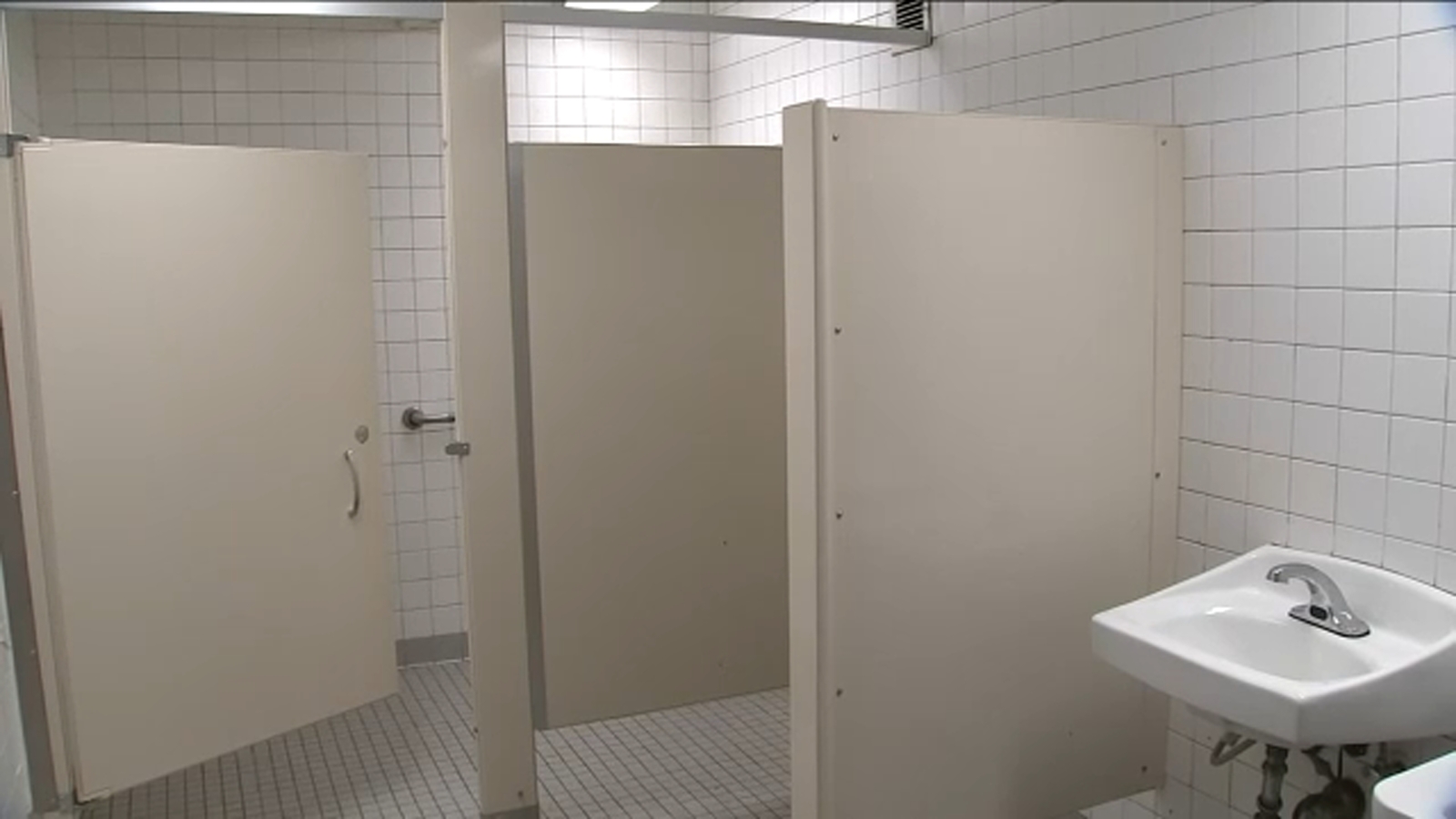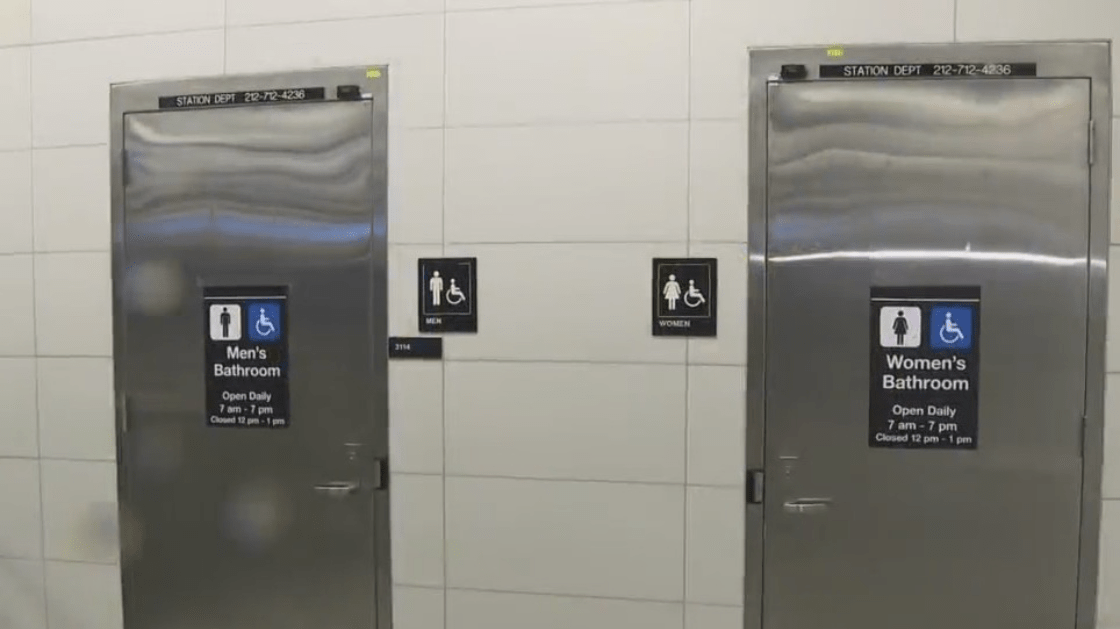Overview
A mental health crisis is playing out on the streets of New York City. Decades of disinvestment have left a behavioral health system with insufficient resources and inadequate capacity at almost every level. The result: We are failing New Yorkers with serious mental illness.
Individuals with untreated psychiatric conditions such as schizophrenia and bipolar disorder too often wind up homeless on our streets. It is critical that we get them the care they need, including hospitalization when necessary. But Manhattan has lost hundreds of in-patient psychiatric beds in recent years. This means that patients who should be admitted for psychiatric care are too often sent back out to the street, and those who are admitted are too often discharged before they are fully stable. A horrible cycle follows.
Those patients who are successfully stabilized by the time they leave the hospital need on-going care through community-based outpatient services, peer-support programs, and more. But here again, a significant lack of capacity means that patients are vulnerable to falling through the cracks and back into crisis.
The most proven, effective long-term support mechanism for people struggling with serious mental illness is supportive housing. But a shortage of units has resulted in a years-long backlog. In the meantime, those without stable housing are far more likely to land back in the streets and subways.
This plan addresses these myriad failings. We are calling for:
- Expansion in the number of long-term psychiatric beds
- Initiatives to address the severe shortage of clinical staff in behavioral health
- Concrete steps to develop more supportive housing
- Expansion of community-based and peer led programs
- Doubling of Intensive Mobile Treatment teams for street outreach
- Giving EMS workers the ability to provide opioid withdrawal treatment medication
These investments will not be cheap. Some will be politically complicated. But our city has a moral obligation to build a system that better serves New Yorkers with serious mental illness. If we don’t act boldly and quickly, a human tragedy will continue to play out on our streets.
1. Create 600+ new in-patient and extended care psychiatric beds in New York City
Create 400 new beds in the Transition to Home program on Randalls Island.
In 2022, New York State launched a new in-patient treatment program for patients experiencing homelessness with serious mental illnesses. The Transition to Home Units (THU) at the Manhattan Psychiatric Center (MPC), a secure facility on Randall’s Island, is designed for recently or chronically homeless patients experiencing serious mental illness who would benefit from patient-centered care to prepare for independent living. Patients are brought directly from public hospital emergency departments when physicians determine that it would not be safe to discharge them.
The THU program in New York City currently consists of only 50 beds. This does not come close to matching the scale of the need. We propose a dramatic expansion, with the addition of 400 more THU beds at MPC’s Randall’s Island campus. This facility includes two large buildings (the north and south wings) which sit entirely vacant. We propose renovating them to be the home of the expanded THU units.
Currently only public hospital emergency departments are eligible to refer patients to the THU, and the vast majority of patients are referred by Bellevue Hospital. The dramatic expansion we propose should allow more public emergency departments to refer patients to THU, and allow private hospitals to participate as well. We propose that funding for the program expansion should in part be funded by contributions from the private hospitals.
Create 240 new Health + Hospitals (H+H) Extended Care Unit beds.
The average stay in H+H’s acute psychiatric inpatient care is a little more than two weeks. Most patients are then discharged, despite the fact that many would benefit from longer-term care. H+H has begun to address this challenge by establishing Extended Care Units (ECUs) at Belleview and Kings County hospitals where patients can stay for months. This voluntary program provides patients with psychopharmacological treatment, rehabilitative activities, and opportunities to strengthen interpersonal and communication skills. The average stay in these units is 90 days. The program has been successful at providing its patients with pathways toward re-acclimating into independent living.
Unfortunately, only 60 beds are available in the ECU program system-wide. This is far below the needed capacity for the city, meaning that most H+H patients who would benefit from such extended-stay psychiatric services do not receive them. To close this gap, we propose dramatically increasing the number of beds in these units to a total of 300, an increase of 240 beds.
2. Address staffing shortages in behavioral health
Hospitals in New York City face a significant shortage of behavioral health staff, including psychologists, psychiatrists, clinical social workers, psychiatric physician assistants, and psychiatric nurse practitioners. This presents a major challenge to the expansion of behavioral health care.
In order to help address these shortages, the MBPO recommends the following steps:
Expand student loan debt forgiveness for behavioral health providers in H+H.
Behavioral health staff often carry large student loan debt, without the prospect of earning salaries as high as many other specialties. This has created a significant obstacle in recruiting and retaining staff in psychiatric professions. To address this challenge, H+H has established the Behavioral Health Loan Repayment Program (BH4NYC). Participating physicians receive up to $50,000 in student debt forgiveness. Non-physician clinicians are eligible for a maximum of $30,000. All participants must commit to working a minimum of three years full-time at H+H.
To date BH4NYC has been funded exclusively by philanthropic contributions, and has only had funding for 32 participants. We propose that the City provide funding for another 200 participants, which we estimate would cost a total of $8 million. Such an expansion would provide a dramatic boost to H+H’s ability to maintain the staffing it needs for critical behavior health care.
Create a CUNY rotation for social work and psychology students at Clubhouse programs.
Clubhouses are community-based sites which help people struggling with mental illness through a program of peer support, a work-centered day, consensus decision making, social and recreational events, employment assistance, and more.
To help awareness of and improve the staffing pipeline for Clubhouses, and to improve understanding of the model by the broader provider community, we propose creating a new clinical rotation at these sites. This would be run by the CUNY schools of social work and clinical psychology, which would create a social practice rotation with student placements in some or all of the Clubhouses in New York City.
Keep up with the cost of living for behavioral health service providers.
Non-profit human service organizations are a critical pillar of New York’s behavioral health system, but the contracts these organizations receive from the City and State provide for salaries which have not kept pace with the rate of inflation. This has resulted in high turnover and vacancy rates for staff in roles that provide critical behavior health and related social services for New Yorkers struggling with serious mental illness. To address this crisis, we are calling on the City and State to establish, fund and enforce automatic, ongoing annual cost-of-living adjustments (COLA) tied to inflation on all human services contracts, including behavioral health services.
3. Create and improve access to supportive housing
Get major supportive housing projects across the finish line.
There is consensus now that supportive housing is highly effective in helping formerly homeless individuals struggling with mental illness to lead stable lives, and avoid returning to the street. Yet in many cases when such housing is proposed for specific sites, there is strong opposition from local communities. In fact, well-run supportive housing projects end up enhancing, not harming, neighborhoods. To address the crisis of serious mental illness playing out on our streets and subways, it is critical that we increase the pace of construction of new supportive housing. The most immediate priority is to ensure projects currently in the pipeline make it to the finish line.
There are three high-priority supportive housing projects in process in Manhattan, all of which have faced some local opposition. It is critical that each of these be built:
- 1727 Amsterdam (at 145th St.) – 120 supportive units & 80 affordable units for families
- The Lirio (at 54th St. at 10th Ave) – 67 supportive units & 44 affordable units for families
- Timbale Terrace (Park Ave at E. 118th St.) – 99 supportive units & 230 affordable units for families
Pass zoning text amendments that would allow for the creation of more affordable and supportive housing.
The Department of City Planning has proposed citywide zoning text amendments, known as “City of Yes for Housing Opportunity”, which would facilitate the creation of more housing in New York City. The proposal includes a new Universal Affordability Preference, which would provide floor area ratio (FAR) bonuses for developments that include either affordable or supportive housing units. We support FAR bonuses that would incentivize the creation of supportive housing. The Borough President also believes that this provision should encourage developers to set aside space for on-site services for supportive housing residents to ensure their ability to remain in permanent housing.
Ensure New Yorkers are placed in the housing that best suits their needs.
Chronically homeless New Yorkers in need of supportive housing in New York City must go through a centralized process to determine eligibility for the two major types of supportive housing – community care, which is permanent supportive housing that provides case management with social workers, and Level II/Licensed beds, which provide wraparound services including medication management. While the City has improved this system to address slow referral times and high vacancy rates, there remain administrative issues that result in placing New Yorkers in the type of supportive housing that isn’t appropriate for their needs or situation. As a result, residents, support staff, and operators are put in situations that lead to conflict and strain. The Human Resources Administration should improve the Coordinated Assessment Placement System (CAPS) to ensure clients are only referred for placement in for the exact type of housing that best suits them.
Ensure that the highest need New Yorkers are prioritized for supportive housing.
While Intensive Mobile Treatment (IMT) Teams can include housing and benefits specialists, it remains difficult to connect to housing due to long wait times and administrative constraints in the overall supportive housing system. IMT clients, among some of our most vulnerable New Yorkers, have already been identified, have a connection to the City, and are already building relationships with trusted service providers. The City should designate a number of supportive housing units as priority slots for IMT clients – allowing IMT staff to connect their clients directly with housing.
Expand family care housing opportunities and peer support programs.
The NYS Office of Mental Health’s Family Care program places New Yorkers with serious mental health diagnoses who are in recovery in a home with a member of the local community. Providers are trained, certified and able to offer the support needed for clients to relearn how to live independently. Placements are often long-term, allowing for clients and family care providers to build strong familial and community connections. There are roughly 23 homes boroughwide serving approximately 100 individuals, but there is strong demand for more capacity. The State and City should ramp up efforts to expand the pool of trained and certified providers by doing more to recruit interested and willing participants into the program.
4. Invest in and expand behavioral health treatment
Double the number of Intensive Mobile Treatment teams from 31 to 62; create capacity to support 1500 New Yorkers in Need.
Intensive Mobile Treatment (IMT) teams are full service mental health treatment teams comprised of psychiatrists, nurses, social workers, case managers, and peer specialists that provide long-term wraparound services directly to New Yorkers – meeting them at shelters, street corners, park plazas, and more. While not all are unhoused, IMT teams’ clients often struggle with chronic street homelessness, serious mental illness, co-occurring substance-use disorders and years of trauma and distrust. These teams offer clients in need basic supports like warm meals and clothes, to long-term psychiatric care, medication and connections to supportive housing.
As of May 2023, the program was comprised of 31 IMT teams, serving roughly 800 New Yorkers across Manhattan, Brooklyn, Staten Island and Queens, with at least 250 more on the wait list. The City should work to double the number of IMT teams and vastly increase the number of New Yorkers connected to ongoing psychiatric care, as well as housing and other forms of support that are needed. The City and State should also allow for more flexibility in the accreditation required to do this work to help address staffing constraints.
Rapidly expand the Certified Community Behavioral Health Clinic model in New York State.
Certified Community Behavioral Health Clinics (CCBHCs) are outpatient clinics designed to help people access the treatment they need before experiencing the type of crisis that could require inpatient and emergency department care. These clinics provide a wide range of care and are required to provide care coordination to help individuals navigate the complicated and often disjointed behavioral health care system. New York State has begun to expand this initiative, but devoting more funding and resources to CCBHCs would allow the city to meet today’s behavioral health challenges head on. The Federal Government has made funding available, and expansion of this model would save public dollars by intervening before inpatient care is required.
5. Improve access to substance use disorder treatment and connections to care
Many New Yorkers with serious mental illness also struggle with opioid misuse, enormously complicating their path to a stable life. The rapid proliferation of fentanyl has made New York City’s overdose crisis even more acute. Fortunately new medication treatments like buprenorphine can help reduce opioid misuse and opioid use disorder-related symptoms. However many of the patients who would benefit from such medications are not receiving them. This is particularly true for New Yorkers with mental illness.
Give EMS workers the ability to provide buprenorphine.
EMS workers are increasingly responding to calls to treat opioid overdose or opioid withdrawal. They are authorized to administer naloxone to revive patients. Typically in such cases the patients refuse transport to hospital, foreclosing the possibility that they would be connected to longer-term treatments and care.
To address this challenge, EMS units in Philadelphia and Pittsburgh are now authorized to administer buprenorphine to patients experiencing opioid withdrawal regardless of whether the patient decides to go to the hospital. Patients are then able to schedule a virtual follow up with a doctor within 24 hours to get a buprenorphine prescription and be connected to other critical harm reduction resources.
New York City should create a similar program. We propose establishing a three-year pilot program during which all 911-participating ambulances serving designated neighborhoods with high overdose rates would be required to carry and offer buprenorphine as part of their services for patients who have been revived from an overdose. This would require training for EMS responders to use the medication, as well as to ensure that EMS could adequately connect patients with nonprofit service providers to ensure they received continued support and care.





